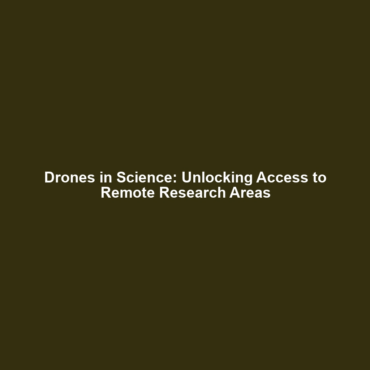Drones in Science: Accessing Remote and Hazardous Environments
Introduction
In recent years, drones have transformed the landscape of scientific research, offering unprecedented opportunities for accessing remote or hazardous environments that were previously deemed unreachable. As drones in science gain traction, researchers are harnessing these technological marvels to gather data from volcanoes, deep forests, oceans, and other challenging terrains. The significance of drones in facilitating research in difficult locations cannot be overstated, as they enable both safety and efficiency in data collection, ultimately advancing our understanding of the natural world.
Key Concepts
Understanding Drones
Drones, or unmanned aerial vehicles (UAVs), come equipped with various sensors, cameras, and communication devices. These features allow scientists to:
- Conduct aerial surveys and monitor changes over time.
- Collect samples in hazardous areas without endangering human lives.
- Gather real-time data for immediate analysis in remote locations.
This technology encapsulates the essence of drones in science by embodying principles of innovation, safety, and accessibility.
Applications and Real-World Uses
The practical applications of drones that provide researchers access to remote or hazardous environments are vast and varied. Some noteworthy examples include:
- Environmental Monitoring: Drones are utilized in tracking deforestation and monitoring wildlife habitats in remote areas.
- Search and Rescue Operations: In emergencies such as natural disasters, drones can swiftly identify inaccessible areas and provide vital information.
- Marine Research: Drones are employed to investigate hard-to-reach marine ecosystems and collect data on fish populations.
These applications illustrate how drones in science are revolutionizing data collection in previously unreachable settings.
Current Challenges
Despite their advantages, the use of drones to access remote or hazardous environments faces several challenges:
- Regulatory Restrictions: Navigating airspace regulations can complicate deployment.
- Technical Limitations: Battery life and payload capacity remain critical issues.
- Data Privacy: Concerns about surveillance and data handling must be addressed.
Understanding the challenges of using drones in science is essential for addressing these limitations effectively.
Future Research and Innovations
The future of drones that provide researchers access to remote or hazardous environments holds exciting potential. Innovations in battery technology promise longer flight times, while advancements in AI are set to enhance data analysis capabilities. Emerging trends also suggest the development of drone swarms for more comprehensive data collection over large areas, ensuring a more efficient research process in drones in science.
Conclusion
In summary, drones are pivotal in granting researchers access to remote or hazardous environments, significantly impacting drones in science. As technology advances, further breakthroughs will enhance our scientific capabilities and understanding of our planet. For more information on related topics, explore our articles on marine research and drone technology innovations.
